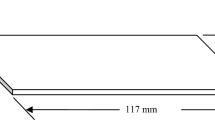Abstract
This paper deals with minimization of sink depths in injection-molded thermoplastic components by integrating finite element (FE) flow analysis with central composite design (CCD) of experiments and genetic algorithm (GA). Sink-mark depth depends on various process and design variables. Out of all, four most influential variables viz. melt temperature, mold temperature, pack pressure, and rib-to-wall ratio were used for optimization. A set of FE analyses were conducted at various combinations of variables based on the CCD array. A second-order-response surface regression model (RSRM) was developed based on the CCD. The second-order model was effectively coupled with GA for optimization of variables to minimize the sink depth. Results are encouraging and the proposed methodology could be used effectively in minimizing sink-mark depths.
Similar content being viewed by others
References
Beall G (1999) Sink and voids, injection molding magazine, IMM, June 1999
Mathivanan D, Parthasarathy NS (2008) Sink mark prediction and optimization—a review. SPE-ANTEC 2008:2126–2132
Shi F, Lou ZL, Lu JG, Zhang YQ (2003) Optimisation of plastics injection moulding process with soft computing. Int J Adv Manuf Technol 21:656–661. doi:10.1007/s00170-002-1374-3
Tursi D, Bistany SP (2000) Process and tooling factors affecting sink marks for amorphous and crystalline resins. J Inj Molding Technol 4(3):114–119
Kazmer D, Rowland J, Sherbelis G (1997) The foundation of intelligent process control for injection molding. J Inj Molding Technol 1(1):44–56
Erzurumlu T, Ozcelik B (2006) Minimization of warpage and sink index in injection-molded thermoplastics parts using Taguchi optimization method. Mater Des 27:853–861
Oktem H, Erzurumlu T, Uzman I (2007) Application of Taguchi optimization technique in determining plastic injection molding process parameters for a thin-shell part. Mater Des 28:1271–1278
Hua Y, Phillip ML (1999) Minimizing part sink marks using C-mold and genetic-optimization algorithm. SPE-ANTEC 1999
Shen C, Wang L, Cao W, Qian L (2007) Investigation of the effect of molding variables on sink marks of plastics injection molded parts using taguchi DOE technique. Polymer Plast Tech Eng 46:219–225. doi:10.1080/03602550601152887
Hayden KF (2005) Development of a statistical model for process control to eliminate sink marks in injection molded products M.S.E Thesis, WMU
Liang J-M, Wang P-J (2002) Multi-objective optimization scheme for quality control in injection molding. J Inj Molding Technol 6(4):331–342
Shen C, Wang L, Cao W, Wu J (2007) Optimization for injection molding process conditions of the refrigeratory top cover using combination method of artificial neural network and genetic algorithms. Polymer Plast Tech Eng 46(2):105–112. doi:10.1080/03602550601152853
Chang RY, Tsaur BD (1995) Experimental and theoretical studies of shrinkage, warpage, and sink marks of crystalline polymer injection molded parts. Poly Eng Sci 35(15):1222–1230. doi:10.1002/pen.760351505
Shi L, Gupta M (1998) A localized shrinkage analysis for predicting sink marks in injection-molded plastics parts. J Inj Molding Technol 2(4):149–155
Shi L, Gupta M (1999) An approximate prediction of sink mark depth in rib-reinforced plastics parts by empirical equations. J Inj Molding Technol 3(1):1–10
Iyer N, Ramani K (2002) A study of localized shrinkage in injection molding with high thermal conductivity molds. J Inj Molding Technol 6(2):73–90
Wang L, Qian L, Shen C, Lu S (2008) Effects of process parameters and two-way interactions on sink mark depth of injection molded parts by using the design of experiment method. Polymer Plast Tech Eng 47(1):30–35. doi:10.1080/03602550701575987
Patel SA, Mallick PK (1998) Development of a methodology for defect reduction in injection molding using process simulations. J Inj Molding Technol 2(4):176–191
Lin T, Chananda B (2003) Quality improvement of an injection-molded product using design of experiments: a case study. Qual Eng 16(1):99–104. doi:10.1081/QEN-120020776
Mathivanan D, Parthasarathy NS (2008) Prediction of sink depths using nonlinear modeling of injection molding variables. Int J Adv Manuf Technol. doi:10.1007/s00170-008-1749-1
MPI user guide Version 6, Moldflow. Notes on sink mark index
Rees H (1995) Mold engineering. Hanser/Gardner, Cincinnati
Haftka RT, Scott EP, Cruz JR (1998) Optimization and experiments: a survey. Appl Mech Rev 51(7):435–448
Montgomery DC (2005) Design and analysis of experiments, 5th edn. Wiley, Singapore
Goldberg DE (1999) Genetic algorithms. Addison-Wesley, Boston
Author information
Authors and Affiliations
Corresponding author
Rights and permissions
About this article
Cite this article
Mathivanan, D., Parthasarathy, N.S. Sink-mark minimization in injection molding through response surface regression modeling and genetic algorithm. Int J Adv Manuf Technol 45, 867–874 (2009). https://doi.org/10.1007/s00170-009-2021-z
Received:
Accepted:
Published:
Issue Date:
DOI: https://doi.org/10.1007/s00170-009-2021-z



